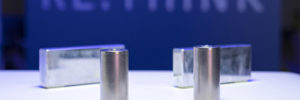The BMW Group has confirmed that it will switch from prismatic battery cells to cylindrical cells for its next-gen Neue Klasse [New Class] architecture. The automaker says the new cell format, combined with improved chemistry and a new kind of battery pack, will deliver better performance, lower costs, and a smaller environmental footprint from battery production.
The first Neue Klasse EVs are expected to appear in 2025, and BMW is talking a mighty big game. “Based on current market assumptions, costs [at the battery pack level] can be reduced by up to 50 percent, compared to the current fifth generation,” say the Bavarians, adding that the company has “set itself the goal of bringing manufacturing costs for fully-electric models down to the same level as vehicles with state-of-the-art combustion-engine technology.”
“The newly-developed sixth generation of our lithium-ion cells will bring a huge leap in technology that will increase energy density by more than 20 percent, improve charging speed by up to 30 percent and enhance range by up to 30 percent,” says BMW Board Member Frank Weber. “We are also reducing CO2 emissions from cell production by up to 60 percent.”
BMW’s newly-developed “round cells” have a standard diameter of 46 millimeters—the same as Tesla’s 4680 cylindrical cells—and will be made in two different heights: 95 and 120 mm. They feature an improved NCM chemistry. “Compared to the prismatic cells of the fifth BMW battery cell generation, the nickel content is higher on the cathode side, while the cobalt content is reduced. On the anode side, the silicon content will be increased.”
The automaker also says that an LFP cathode could be an option.
The new system appears to embody the hottest trends in pack design—it’s based on an 800 V, 500 A architecture, which will enable much faster charging, and it uses a cell-to-pack design (no modules). BMW is also hinting at a structural battery pack a la Tesla: “The battery system plays a key role in the body structure of the Neue Klasse. Depending on the model, it can be flexibly integrated into the installation space to save space.”
New factories to build the new cells are in the works. “To meet our long-term needs, we will be building battery cell factories with our partners, each with an annual capacity of up to 20 GWh, at six locations in key markets: two in China, two in Europe and two in [North America],” said Board Member Joachim Post. “We have also reached agreement with our partners that they will use a percentage of secondary material for the lithium, cobalt and nickel, as well as using green power for production, to ensure CO2-reduced manufacturing.”
Source: Charged EVs
